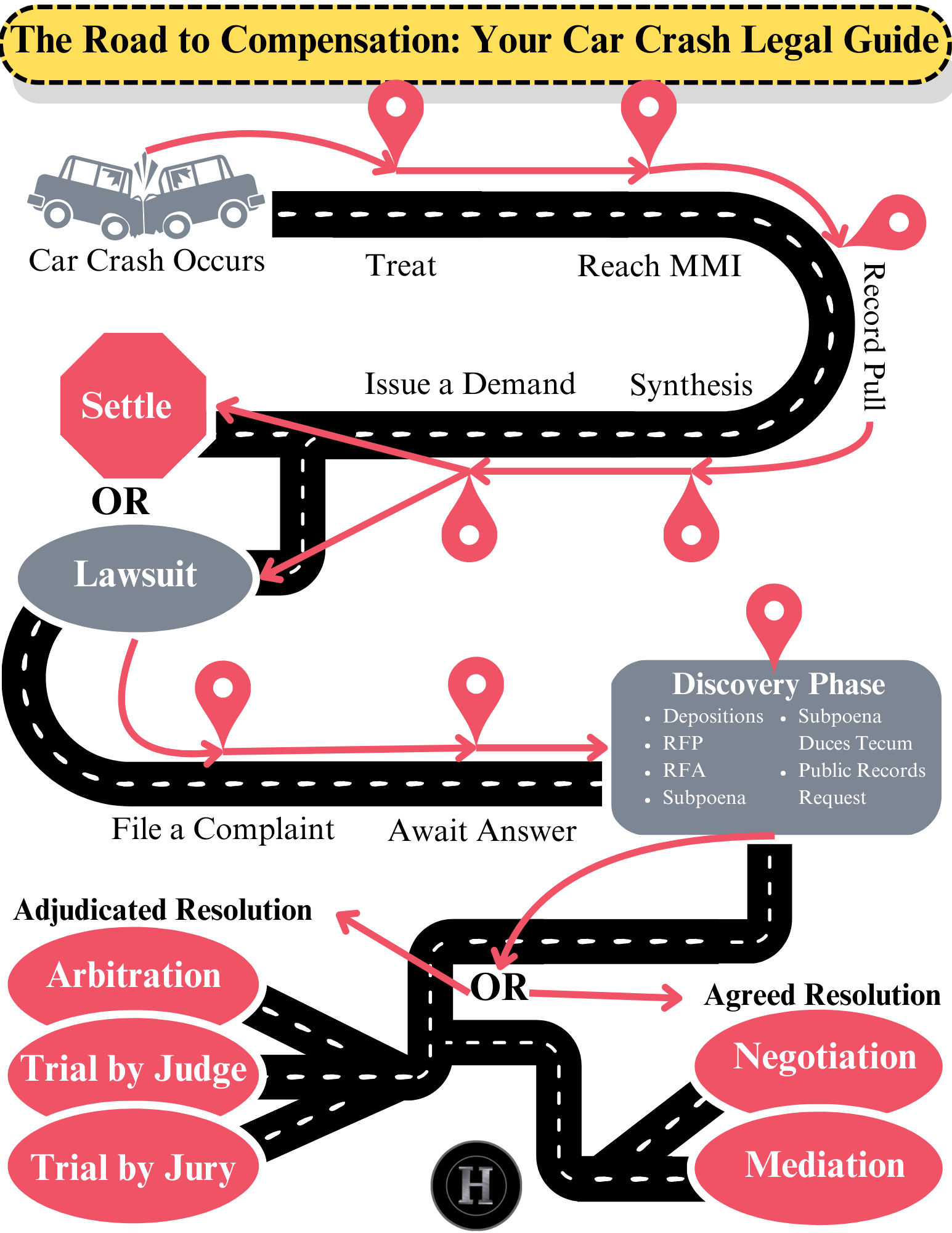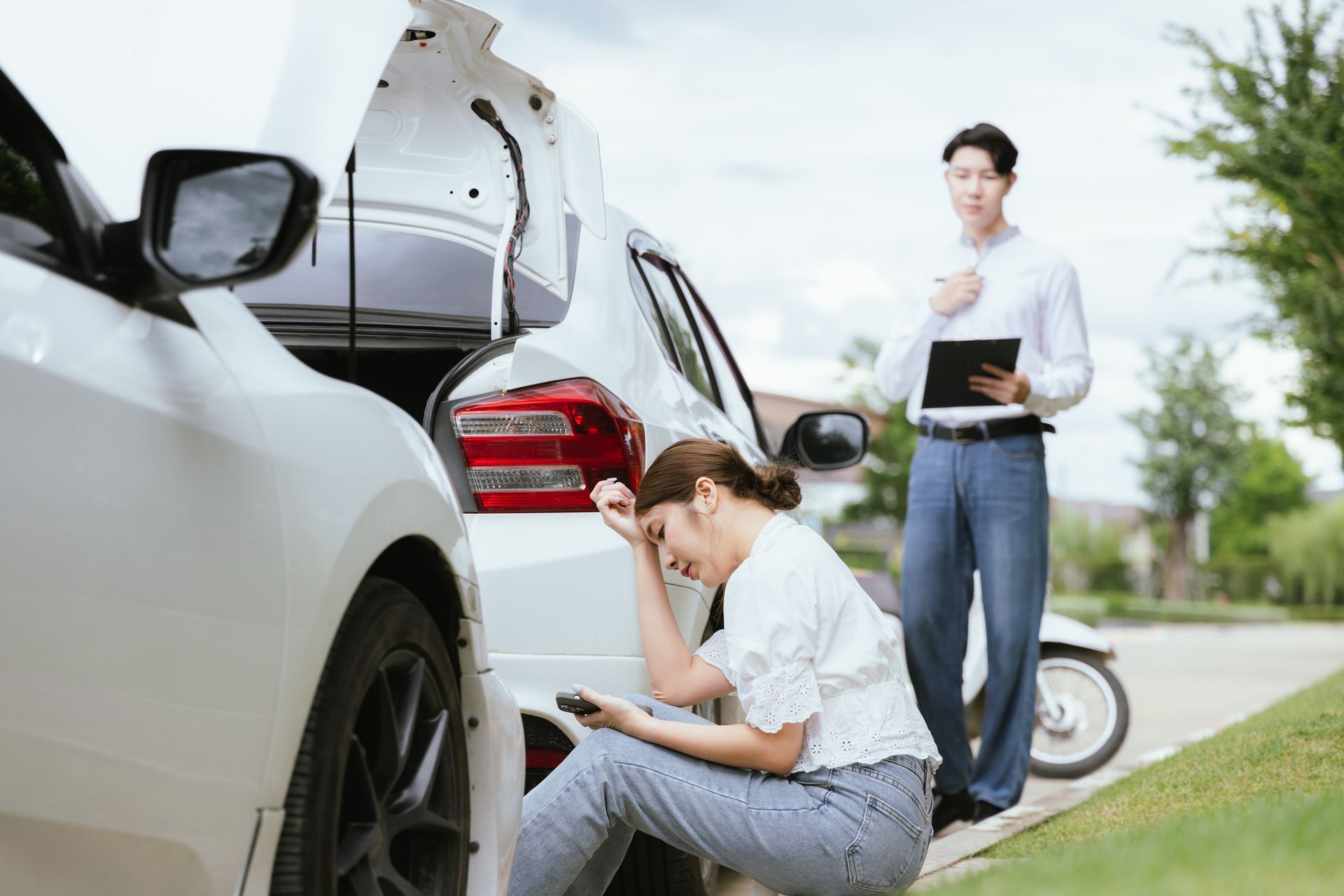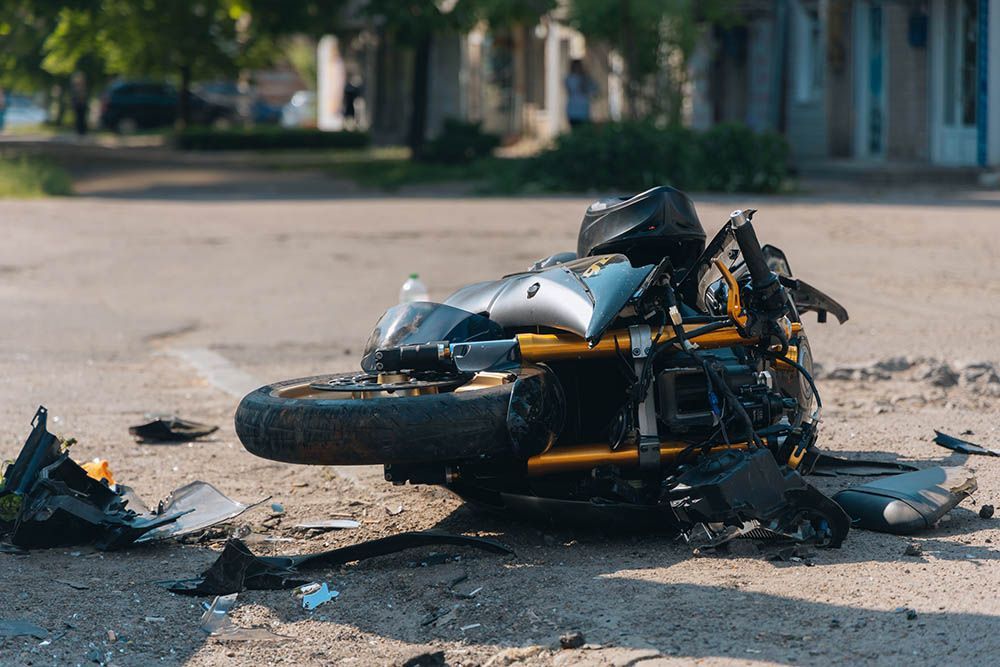The Road to Compensation: Your Car Crash Legal Guide

What is this crazy infographic thing? What can I learn from it?
We at Hunking Law put dozens of man-hours collaboratively into generating this infographic because we thought it would be helpful to clients. The goal is to take the collective knowledge of the people who work here, gained step by step over years of education and practice, and make it digestible to a potential client. The information is organized into a flow which is a pretty good way to understand how these car crash cases work and what to expect next.
The information itself is layered and while each section has a summary the depth of each summary is vast. The scope of knowledge needed to understand a complaint is really broad and not really something that can be understood fully within an infographic, but understanding the steps and the process we hope will put you a little more at ease when you are faced with being injured in an auto collision.
As you read each section and understand it as sort of the next step on the journey feel free to think about why each step is the way it is and by what process are we really reaching a resolution to these conflicts such that you frame the information usefully in your head. At any point, if you think you need more clarification don’t worry, just give us a call and a member of our experienced team will be happy to provide you any clarification you need on any of the points.
We are here to help with car collision cases and we hope this infographic is a useful way to help make your life better.
Down the Road Step by Step
Disclaimer
It is important to note that this resource specifically applies only to Oregon law. Other states may have different processes. If you are unsure about the legal process in your state, call an attorney in your area.
This resource is not intended to be specific legal advice, but rather general information about the common legal process of a car crash case in Oregon. This resource is not a replacement for specific and personalized legal advice. If you were injured in an accident, call an attorney in your area. If you were injured in Oregon, consider giving us a call.
Treat and MMI
The process begins, as you can imagine, with a car crash. This process is explained for the case where the client is not at fault for the accident. The first step towards getting compensation is to treat your injuries. This step involves seeking out medical treatment for your accident-related injuries. Eventually, you will reach a point in your treatment where you are either fully healed or have recovered as much as possible and are not expected to improve further, which is known as Maximum Medical Improvement (MMI).
Gathering and Using Information
Once you have reached MMI, inform your attorney who will preform a record pull. They will reach out to anyone who may have records related to the crash – the police, medical providers, insurance companies, and you, yourself. This can include recordings, pictures, medical records, police reports, or anything else related to the accident. Once all the records are gathered the attorney can move on to synthesis. In this step, the attorney organizes this information and builds it into a concise and comprehensive story of what exactly happened.
Crossroads
Next, the attorney will issue a demand. This is a letter that is sent to the at fault party and their representatives that outlines the case facts, the legal basis for the damages claim, and provides supporting documents that justify the demand amount. At this point, we reach a crossroads. Either the at fault party will accept the demand and propose a settlement amount, or they will reject it, which might lead to a lawsuit. If you accept the settlement, then the case is over without having to go to trial! If it is rejected, then a lawsuit must begin to continue to pursue compensation.
Lawsuit
The lawsuit begins with your attorney filing a complaint, which is a legal document initiating the lawsuit against the at fault party. The attorney then awaits an answer, which is the legal response to a complaint.
Discovery Phase
From here we move into the discovery phase. This includes several ways of collecting clear information about the crash. Depositions involve taking oral statements from witnesses under oath and on-record. A Request for Production (RFP) asks the opposing party to provide documents or tangible evidence. A Request for Admission (RFA) is a formal written request that asks a party to admit or deny facts, verify the authenticity of documents, or respond to legal questions. The difference between these two is that an RFP seeks physical or digital evidence, while an RFA is used to confirm or deny specific facts, which may relate to the requested evidence. A subpoena uses the authority of the court to compel a person or entity to show up and testify in court. A subpoena duces tecum does the same but requires that the person or entity also bring documents with them. Finally, a public records request specifically asks a government entity to disclose records that they maintain that are related to the crash.
Forms of Resolution
Finally, once everything is ready, it is time to come to a resolution, where the two parties agree to come to a compromise. There are several different ways this can go. The parties can either pursue an agreed resolution or an adjudicated resolution. Under an agreed resolution, the two parties come to an agreement outside of a trial. Negotiation is where the two parties come together and reach an agreement to the dispute. Mediation is where a neutral third party helps the two parties come to an agreement. Alternatively, the resolution can be done through an adjudicated resolution. This includes arbitration, where each side presents their case to an arbitrator who decides for the parties what the resolution is. Alternatively, there can be a trial by judge, where the two parties present their cases to a judge who decides what the resolution is, or trial by jury, where the jury decides based on the cases presented to them and the application of the law given to them by the judge.
Lastly, if the losing party is unhappy with the result and believes there were legal mistakes in the case, they can ask for a higher court to hear the case and consider the original decision through appeals. However, the new court can only look for legal mistakes and whether this changes the court’s final decision or not.
Driving it Home
As you can see, the legal process is long and involved and has many ways that it can go. Don’t worry though, if one of our attorneys takes your case, we will take care of just about everything; just make sure to respond promptly when we request information from you.
It is our hope that this resource can serve as a roadmap for a car crash case; to demystify the process and define key terms that may come up throughout the case. One important point is that the bulk of the legal process does not really begin until after you have reached MMI, which for some people can take a long time. The process also relies heavily on the responses of other entities for records, or the at fault party for answers. This is where a car crash case can really drag on for a long time. We do all that we can to keep our end of the process prompt and efficient, but we can’t control how long it takes for everyone else involved in the process.
If you were just injured in a car accident, try not to be too overwhelmed. Call an attorney in your area and review this resource to know what to expect. Don’t be afraid to ask questions and be ready for a long process.
Get Help Now
Please Share
Did you find this helpful? Please share it! This is important information that every driver should know!










